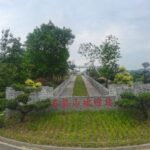Taihe Mountain, formerly known as ‘Qingtian Mountain’, is located in the northern part of Hecheng Town in Qingtian County and serves as an urban park for the residents of Qingtian. Historically, white cranes inhabited the mountain, giving Taihe Mountain and Hecheng Town their names, and it is characterized by its typical low-hill topography. It is said that in the Tang Dynasty, Taoist Ye Fashan practiced alchemy and swordsmanship here, achieved enlightenment, and ascended to heaven riding a crane, thus being listed as the 30th Taoist sacred site.
Taihe Mountain is distinguished by its ancient pines and peculiar rocks. The main peak of Taihe Mountain stands at an elevation of 144.1 meters, with extensive exposed rocks on the slopes and numerous ancient pines and peculiar rocks, with vegetation coverage exceeding 85%. Ancient pines, peculiar rocks, cliff inscriptions, and ancient temples and pavilions are the hallmarks of Taihe Mountain. Most of the ancient pines in Taihe are thin-skinned high-yielding pine trees belonging to the Pinus massoniana of the Pinaceae family. The rocks of Taihe Mountain are uniquely shaped, with formations such as Hunyuan Peak and Xiaoshun Rock. Hunyuan Peak, located atop Taihe Mountain, features a relatively exposed main rock body that resembles a square seal with a ‘cross’ shape, a result of structural geological joints. Ancient visitors to Taihe Mountain found ancient pines accompanied by peculiar rocks, with inscriptions such as ‘Fu Song Shi’ and ‘Shi Fu Song’, which are true depictions of the ancient pines and strange rocks here. Taihe Mountain has over 50 cliff inscriptions, including names, poems, and carvings, with various calligraphic styles such as regular script, running script, cursive script, seal script, and clerical script. Notably, the ‘Willow Branch Guanyin’ line carving on the southeast rock wall of Hunyuan Peak stands out, with a clear image measuring approximately 3.8 meters in height and 1.6 meters in width, inscribed with ‘Ming disciple Zheng Kuiguang wrote’. It is similar to the Willow Branch Guanyin statue at Yangzhi Temple on Putuo Mountain, which was established in the 36th year of the Wanli era (1608). Such a large-scale Willow Branch Guanyin carving is rare in our province. Huancui Temple is a Buddhist activity site in Qingtian, facing north and south, with a construction area of over 1800 square meters. The main structures include Huancui Temple, Mahavira Hall, and the three-story hall (Round Hall, Three Views Hall, Reclining Buddha Hall), which were originally built at the end of the Ming Dynasty and the beginning of the Qing Dynasty, and have been rebuilt multiple times after being destroyed. Liu Chengyi Bo Temple is a venue in Qingtian Hecheng to commemorate the historical traces of Liu Ji, built in the 10th year of the Jiajing era (1531), with a construction area of about 300 square meters. Taihe Mountain also features more than 10 pavilions, including Xie Qiao Pavilion, Jianyu Pavilion, Wenhe Pavilion, and Tingtao Pavilion. Among them, the earliest is Xie Qiao Pavilion, built in memory of the Southern Dynasty poet Xie Lingyun. The original construction date of this pavilion is unknown; it was destroyed in the first year of the Tongzhi era and rebuilt in the twelfth year, with a square layout and an area of 25 square meters. The park is open all year round from 07:00 to 18:00, with specific business status subject to the day’s opening conditions.Taihe Mountain Park
Taihe Mountain, formerly known as ‘Qingtian Mountain’, is located in the northern part o[...]









